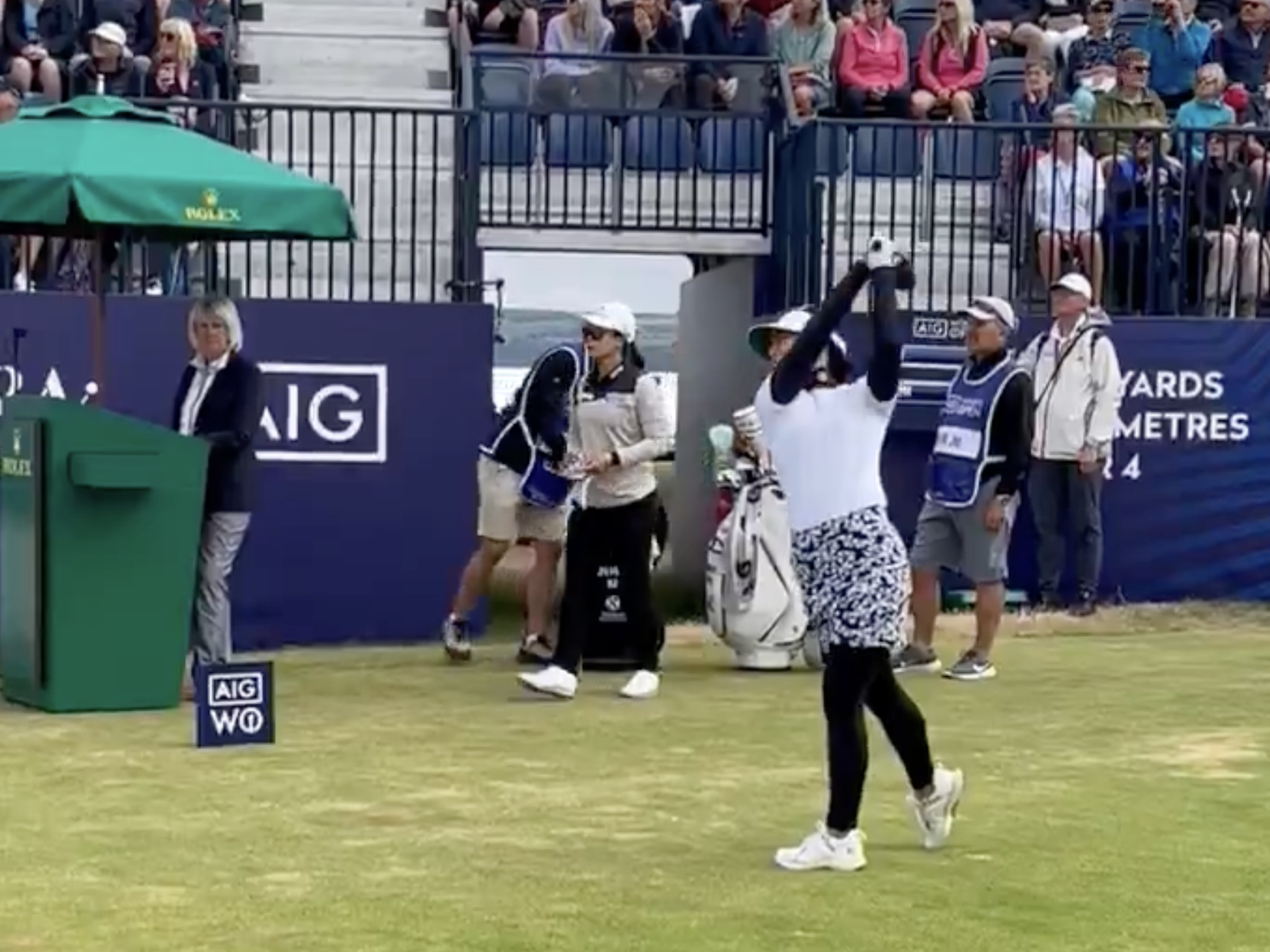19th Hole
A hacker plays the big ones: Pt. 3

A Hacker Plays The Big Ones” is a short story authored by Steven R. Roberts. The short story, written two months following the trip, tells the tale of Roberts and his friend, Bob Blackman’s, golf odyssey around Scotland in the 1970s where the two played four of most historic courses in the game: St. Andrews, Carnoustie, Muirfield and Gleneagles.
We have broken the short story into a four-parter and will publish Part 4. of the story in the coming days.
Bob and I hadn’t had much to say to each other on the trip down from Perth, but the normal golf babble broke out as we saw the Royal and Ancient Clubhouse and sensed the moment was near.
“What if we take a divot?” I asked.
“You replace it. What else?” Bob said.
“I was just imagining a juicy chunk of this place framed, under glass, hermetically sealed and hanging in my den back home,” I said.
“I think you may be having a histrionic, historic fit,” Bob said.
He was right. I needed to pull myself together and get mentally tough for the match of the day. There was a lot of ground to make up on Bob and the wooden-shafted devil.
I leaned over the first tee rail and held out the money to pay for the greens fees.
“Step baack, lod,” the cashier man said. “I’ll tull ya when ya kin pie.” The cashier and the starter were definitely in control of when and if those of us standing in the misty rain could play.
George III could have used these guys. The King outlawed the game twice during his reign. Even in those days, politicians would stoop to any level for the ladies’ approval.
After the setback involving a pink tee, and after I hit my second shot into the Swilcan Burn that runs in front of the first green, we were on our way. I took a double-bogie six and thought I understood better why they call the stream a burn.
The course was essentially a narrow strip of land along the sea, with the front nine going out and the second nine coming back. Some of the greens were so big they were used for a hole going out on one half of the green and a pin on the other side of the green for the hole coming back. Some fairways are also shared and, in fact, two of the fairways crossed each other.
My round for the day seemed almost of secondary importance as I drank in the history and stark beauty of the course jammed against the rugged sea. I managed to concentrate long enough to birdie 14 and 15; Bob birdied 3 and 12.
In the end, I had some disasters and finished with an 81 while the devil and his friend had a steady 78. It just goes to show, you must be very careful in choosing your traveling friends. Next time I’m going to find somebody 75 years old with a bad back and enough social grace to give me a few three-footers.
In no time at all, it hit me that the long-awaited round was going to be over too soon. The mist had stopped by the time we looked down the fairway from the 17th tee. The tee shot on the notoriously difficult hole must start down the left side of the fairway and fade or go over the edge of the hotel positioned helplessly at the corner of the dogleg. We navigated the corner successfully but noticed many pock marks on the side of the building from less fortunate.
Bob and I walked up on the 18th tee just 2 hours and 45 minutes after teeing off. Off to our left, we could see the first tee was still crowded with players anxious to chase their dreams. I walked tall, visualizing the thousands of spectators standing along Golf Avenue to the right and the grandstands behind the square green holding 8,000 fans on tournament Sunday.
This was the final hole, and I had a chance to win the British Open by besting Palmer and Nicklaus by a stroke. I needed only a par on the final hole. I visualized a par because there was no way I could birdie the hole in front of thousands of people and all of the press and TV crews jammed against the ropes. Actually, Doug Sanders walked up to his drive the final day in 1972 needing only a par to win. I looked for Sanders’ divot, but it had healed over.
Bob and I were both over the road that bisects the hole and Bob was away. Let me clarify. I out-drove good old Bob. He hit a pitch and run shot that reached the front edge of the green.
For me, it was enough of a test just to pull the club back for the second shot. I selected a wedge and went down through the green sod, soaked by rain the night before while I had been incarcerated.
My shot took off high but was pulled to the left, just catching the edge of the large green. The crowd went nuts, or so it seemed. As I walked forward to pick up the turf and return it to its honored place, I took one last look back at St. Andrews.
“I’ll be back someday, old man by the sea,” I said out loud. “You will know me. Next time I’ll have a left-handed, wooden-shafted putter and you won’t have a chance.”
Bob struck his 120-foot putt well with that stupid-looking putter. The ball hit the hole and stopped two inches away. The two people clapping as they walked along the railing behind the green represented the 20,000 there each time this course hosts the Open Championship.
If I could somehow sneak in my 32-footer, I could pull within five shots of the young, albeit cheating, left-handed Australian. My putt was pure and in all the way but somehow hit the lip and spun out. The couple along the rail let out an “ohuuu” in unison.
Is there no justice? As I lined up the curling two-footer return putt, I remembered that Doug Sanders had this same putt to best Jack Nicklaus and win the championship in 1972. The official silversmith was already carving his first name in the trophy when the unbelievable happened. Sanders missed the putt. He would go on to lose the playoff with Nicklaus the next day.
Out of respect, I too missed the very same two-footer. I could have made it if I had wanted to. Honest, I could have
Coming soon: A Hacker Plays The Big Ones Pt. 4
19th Hole
‘Don’t think I’ll sleep well tonight’ – LPGA pro offers candid take following rough AIG Women’s Open finish

An opening round of 77 left LPGA pro Jenny Shin with a mountain to climb at last week’s AIG Women’s Open.
However, fighting back with rounds of 69 and 67, Shin found herself six shots off the lead and just outside the top 10 heading into Sunday as she went in search of her first major victory.
Shin, who won the US Girls’ Junior at just 13, couldn’t back those rounds up on Sunday, though, and after playing her opening nine holes of the final round in level par, she then bogeyed three holes coming home to slip down the leaderboard and eventually finish T23.
Taking to X following the final round, Shin offered a frustrated and honest take on how she was feeling, posting: “Don’t think I’ll sleep well tonight. What a crappy way to finish.”
Don’t think I’ll sleep well tonight. What a crappy way to finish
— Jenny Shin (@JennyShin_LPGA) August 3, 2025
Shin has made 11 cuts in 13 starts on the LPGA Tour this season, but has been plagued by frustrating Sunday finishes throughout the year. Shin ranks 102nd on tour this year out of 155 for Round 4 scoring in 2025.
Miyu Yamashita won the 2025 AIG Women’s Open with a composed final round of 70 to win her first major of her career by two strokes.
19th Hole
How a late golf ball change helped Cameron Young win for first time on PGA Tour

Cameron Young won the Wyndham Championship on Sunday for his first victory on the PGA Tour.
Young dominated all weekend at TPC Sedgefield, running away from the pack to win by six strokes and put himself in contention for a Ryder Cup pick in September.
Ahead of the event, the 28-year-old switched to a Pro V1x prototype golf ball for the first time, following recent testing sessions with the Titleist Golf Ball R&D team.
Interestingly, Young played a practice round accompanied by Fordie Pitts, Titleist’s Director of Tour Research & Validation, at TPC Schedule early last week with both his usual Pro V1 Left Dot ball and the new Pro V1x prototype.
Per Titleist, by the second hole Young was exclusively hitting shots with the Pro V1x prototype.
“We weren’t sure if he was going to test it this week, but as he was warming up, he asked to hit a couple on the range,” Pitts said. “He was then curious to see some shots out on the course. Performance-wise, he was hitting tight draws everywhere. His misses were staying more in play. He hit some, what he would call ‘11 o’clock shots,’ where again he’s taking a little something off it. He had great control there.”
According to Titleist, the main validation came on Tuesday on the seventh hole of his practice round. The par 3 that played between 184 and 225 yards during the tournament called for a 5-iron from Young, or so he thought. Believing there was “no way” he could get a 6-iron to the flag with his Left Dot, Young struck a 5-iron with the Pro V1x prototype and was stunned to see the ball land right by the hole.
“He then hits this 6-iron [with the Pro V1x prototype] absolutely dead at the flag, and it lands right next to the pin, ending up just past it,” Pitts said. “And his response was, ‘remarkable.’ He couldn’t believe that he got that club there.”
Following nine holes on Tuesday and a further nine on Wednesday, Young asked the Titleist team to put the ProV1x balls in his locker. The rest, as they say, is history.
19th Hole
Rickie Fowler makes equipment change to ‘something that’s a little easier on the body’

Rickie Fowler fired an opening round of one-under par on Thursday at the Wyndham Championship, as the Californian looks to make a FedEx Cup playoff push.
Fowler is currently 61st in the standings, so will need a strong couple of weeks to extend his season until the BMW Championship, where only the top 50 in the standings will tee it up.
Heading into the final stretch of the season, Fowler has made an equipment switch of note, changing into new iron shafts, as well as making a switch to his driver shaft.
The 36-year-old revealed this week that he has switched from his usual KBS Tour C-Taper 125-gram steel shafts to the graphite Aerotech SteelFiber 125cw shafts in his Cobra King Tour irons, a change he first put into play at last month’s Travelers Championship.
Speaking on the change to reporters this week, Fowler made note that the graphite shafts offer “something that’s a little easier on the body.”
“I mean, went to the week of Travelers, so been in for, I guess that’s a little over a month now. Something that’s a little easier on the body and seemed to get very similar numbers to where I was at. Yeah, it’s gone well so far.”
Fowler has also made a driver shaft change, switching out his Mitsubishi Diamana WB 73 TX for a UST Mamiya Lin-Q Proto V1 6 TX driver shaft in his Cobra DS-Adapt X, which he first implemented a couple of weeks ago at the John Deere Classic.
However, according to Fowler himself, the testing and potential changes are not done yet.
“Probably do some more testing in some different weight configurations with them once I get some time. Yeah, I feel like we’re always trying to search, one, to get better but are there ways to make things easier, whether that’s physically, mentally, whatever it may be. So yeah, I thought they were good enough to obviously put into play and looking forward to doing some more testing.”
Fowler gets his second round at TPC Sedgefield underway at 7.23 a.m ET on Friday.









